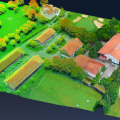
Scientists aboard a U.S. Navy research vessel are using sonar to create detailed maps of the ocean floor from South Africa to Chile.
The research ship Melville departed Cape Town on February 20, and has since been mapping the sea floor using a sonar system, with mountains as tall as 4,500 metres having been mapped.
Most of the seafloor maps seen today were created using satellite data, which is less accurate. Maps created from ship data are much more accurate, but, due to the great time and money costs, only seven per cent of the deep ocean has ship data associated with it.
According to David Sandwell, a professor of geophysics at the Scripps Institution of Oceanography in California, it would take a single ship equipped with a sonar scanner 125 years to map the deep ocean basin completely.
As of 7 March, the Melville was heading past the Falkland Islands. When it reaches Valparaiso, Chile, it will pick up other researchers who hope to study the effects of last year's Chilean earthquake on the seafloor.







